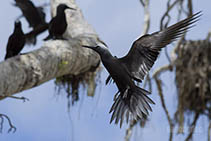Anous minutus Boie, 1844
Black noddy
Classification / Names Common names | Synonyms | CoL | ITIS | WoRMS
Aves | Charadriiformes | Laridae
Environment: milieu / climate zone / depth range / distribution range Ecology
Others. Tropical; 33°N - 37°S, 104°E - 12°E
Distribution Countries | FAO areas | Ecosystems | Occurrences | Introductions
Indo-Pacific and Atlantic Ocean.
Length at first maturity / Size / Weight / Age
Maturity: Lm ? range ? - ? cm Max length : 39.0 cm TL male/unsexed; (Ref. 8812); max. published weight: 144.00 g (Ref. 356)
Short description Morphology
Life cycle and mating behavior Maturity | Reproduction | Spawning | Eggs | Fecundity | Larvae
Main reference
References | Coordinator | Collaborators
Lusk, M.R., P. Bruner and C. Kessler 2000 The Avifauna of Farallon de Medinilla, Mariana Islands. Journal of Field Ornithology 71(1):22-33. (Ref. 5591)
IUCN Red List Status
(Ref. 130435: Version 2025-1)
CITES status (Ref. 108899)
CMS (Ref. 116361)
Threat to humans
Human uses
| FishSource |
Tools
More information
Max. ages / sizes
Length-weight rel.
Length-length rel.
Length-frequencies
Mass conversion
Abundance
Maturity
Fecundity
Spawning
Eggs
Egg development
Larvae
Internet sources
BHL | BOLD Systems | CISTI | DiscoverLife | FAO(Publication : search) | Fishipedia | GenBank (genome, nucleotide) | GloBI | Gomexsi | Google Books | Google Scholar | Google | PubMed | Tree of Life | Wikipedia (Go, Search) | Zoological Record



